woodstove installation
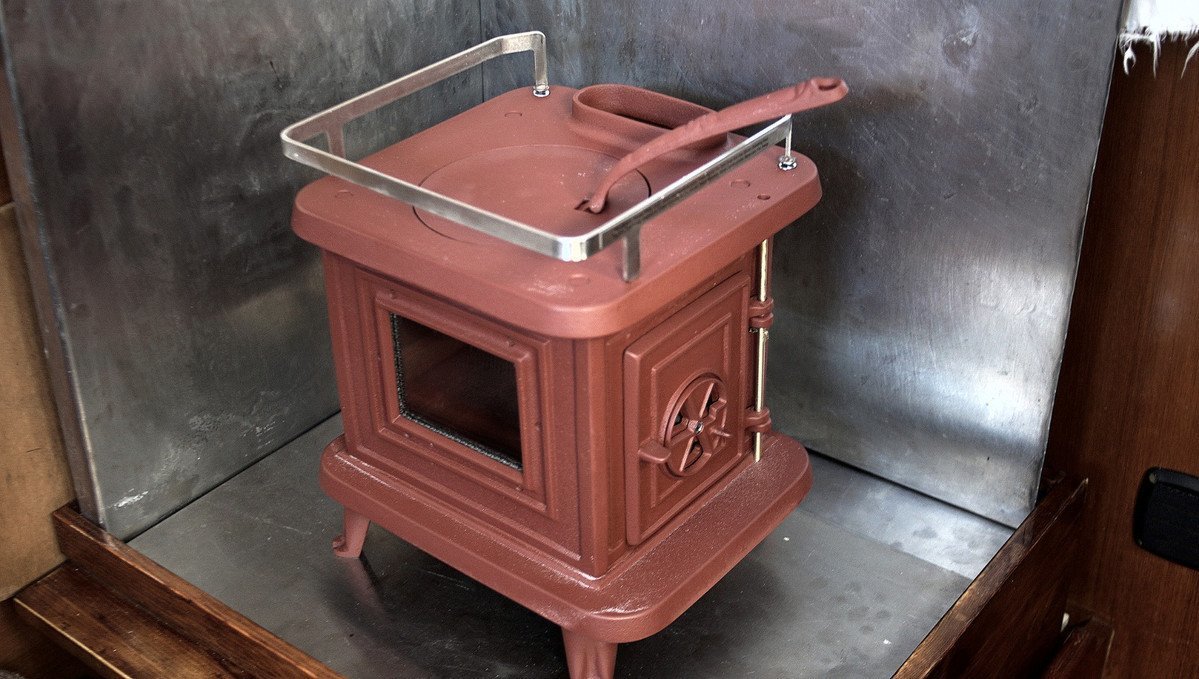
2021.03.28
Victoria BC, Canada.
Click below dates for more recent updates:
Content
- Why a woodstove?
- Planning the installation
- The lost locker
- The platform
- Wall shielding
- Floor protection
- Stove pipe
- Flue damper
- Deck ring
- Deck iron
- Smoke head
- Fan
- Stove tools
- Pipe shield
- Wood box
- Resources
Why a wood stove?
It was our dream to have a little wood stove aboard Pino. After researching stoves, we decided that the best model was the cast iron Sardine stove from Navigator Stoveworks.
Our Espar diesel heater broke on our passage across the north pacific ocean, and we decided not to replace it. There are few low-power alternatives to a gas/diesel heater for heating a boat when off the grid. A wood stove was our best option. We also like that it doubles as a cook top.
Planning the installation
We ordered a stove with red, high temp paint. An enameled coating would have been better, to protect the cast iron from salt air and moisture, but the wait time is much longer (up to 2 years). We decided that high-temp paint was enough, and it meant that we would get the stove much sooner.
We ordered our stove in November 2020, and received it in late March 2021. We hoped to go pick it up ourselves with the boat at Orcas Island, where it's made, but the borders were still closed because of the coronavirus pandemic. We had it shipped instead.
A stove needs a lot of room, but we were prepared to make space for it. In the end, we didn't have to sacrifice too much. We found a spot for it on the port side settee, over our main water tank.
When planning the install, we made a rough model of the stove with wood to figure out how to align the flue to the ceiling. We followed the guidelines recommended by our stove builder.
We built a sturdy platform to support the stove, because we could not bolt it directly to the water tank underneath. Also, we wanted to elevate it to keep access to two deck plates on top of the tank (we open them when cleaning the inside of the tank). We also could not press it up against either wall, because one was storage for our fold-away table, and the other housed a small locker, which gives us access to chain plate bolts.
With these limitations in mind, we planned our installation.
The lost locker
We removed the hinges, and bolted little supports out of wood on the wall for the door to slide into. If we need to reach into that space, we can remove the door out from the side. It is not easy to store items there anymore, but that's okay, our main goal is to keep hand access to the chain plate bolts.
The platform
We built a platform out of pine. We are lucky to have a hardware store nearby that can make cuttings on-site with a bench saw. We don't have access to such tools, and it is hard to make straight, precise cuts without one. They cut a 1.27 cm (1/2 in) groove in 3 planks for the platform floor to slide into. We added screws, and little brackets in the inside corners to hold the walls and floor together.
Pine is a light color, so we stained it with coffee to match it with the rest of the woodwork. We'd read of hobbyists using coffee as a stain. It is cheap, doesn't stink and looks really good! We added a layer of epoxy resin to seal the wood and coffee stain to protect it from moisture (and to deter coffee-loving insects).
The floor of the platform was later reinforced with a length of teak. The platform leaves room for a drawer underneath, where we can store tools or stove accessories, while allowing access to the water tank. We attached the platform to the port-side wall with two long hex bolts, bolted through the wall and secured with oversized washers and lock nuts. The side of the platform that is facing the center of the boat is secured by tension with ropes (sounds weird, but it works).
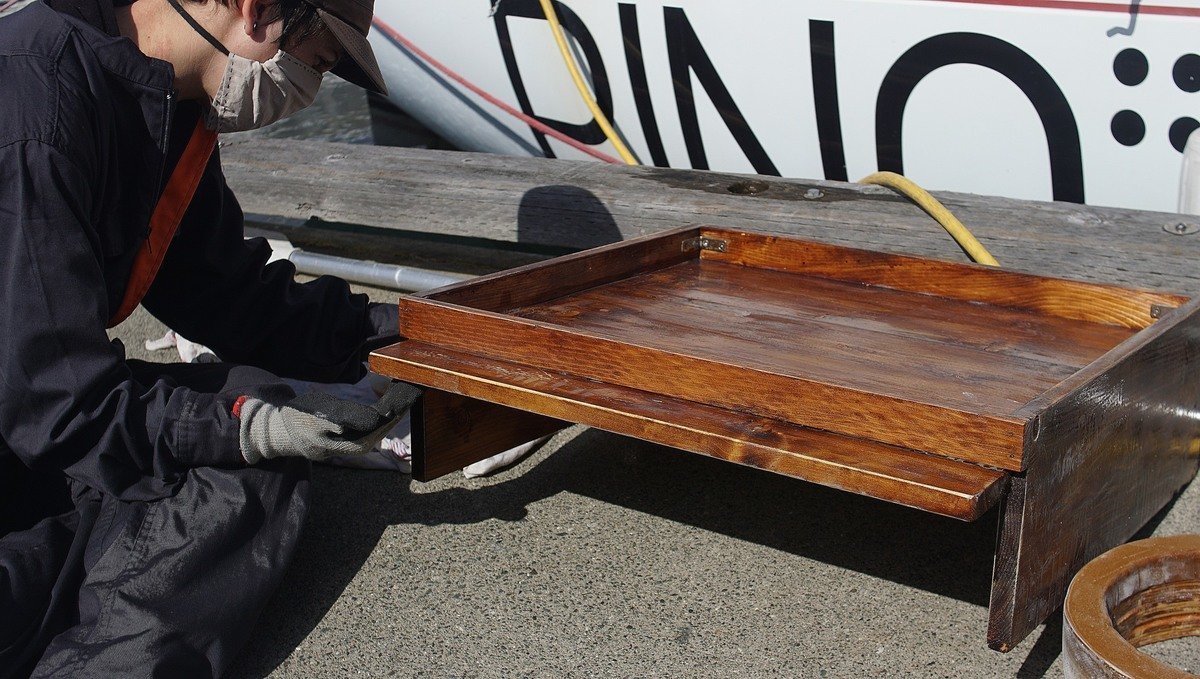
Wall shielding
Shielding is important on a boat due to the fact that most boat building materials or finishes located near the stove will not have a Flame Spread Index of 75 or less. A shield will protect combustible materials in the vicinity of the stove.
The most effective heat shields are the air-cooled type, separated by a thick sheet of stainless steel with 2.54 cm (1 in) or more of air space behind the metal sheet and around the edges to allow air to flow. A proper air-cooled heat shield reduces clearances by up to two thirds.
Our stove builder recommends making a composite panel, mounting a sheet of mineral fibre board behind it to further reduce clearances. Because we exceeded the minimum air space requirements, we did not add one.
We found some stainless steel sheets and shelves at a scrap yard—these items were likely salvaged from a restaurant. The shelf was thick, it had folded edges—which was perfect to make a shield with (makes for a nicer finish). We didn't have access to a place that could bend sheets of metal for us, so we were glad to skip that step. We cut the shelf in half using a grinder, and sanded the edges (because they are sharp).
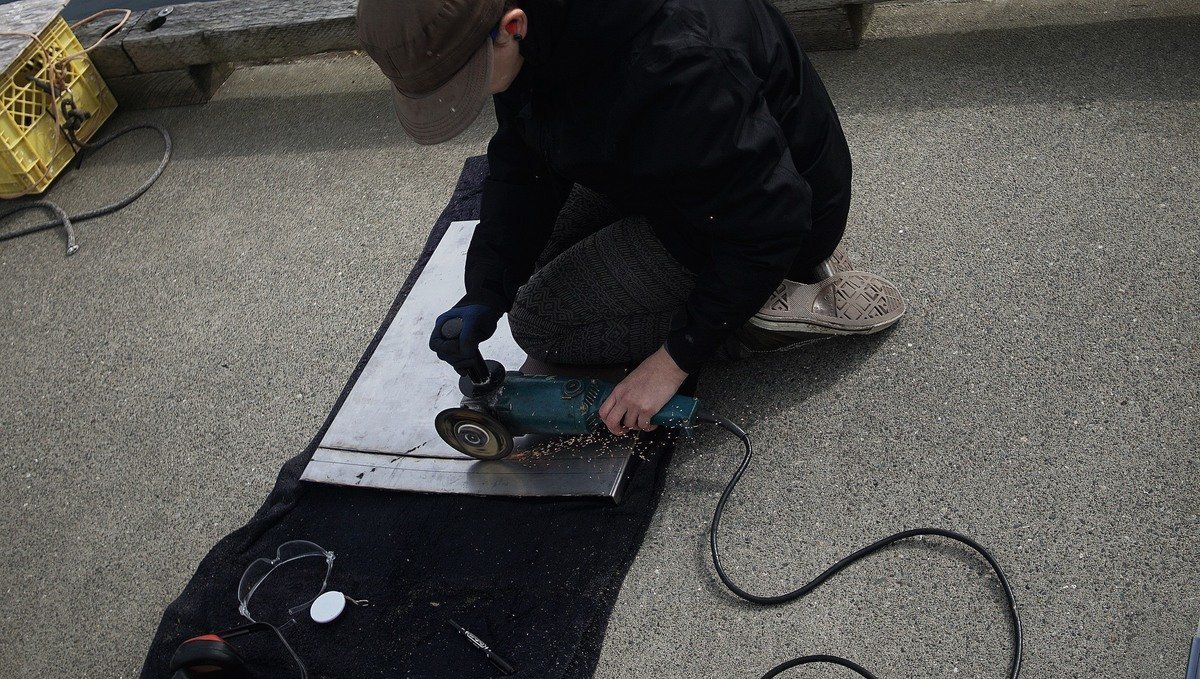
We used a lot of cobalt drill bits to make holes in the shield. Drilling through stainless steel is difficult, and long. The key is to go slow, hard, and to use plenty of lubrication. The sound is also hard on the ears, we wore both protective eyewear and ear plugs when doing the work.
We secured the two cut sheets of metal together with bolts to form a corner. We also drilled holes at the top extremities of the wall shield to secure it to the wall. We followed our builder's advice, keeping bolts on the extremities of the shield rather than in the center.
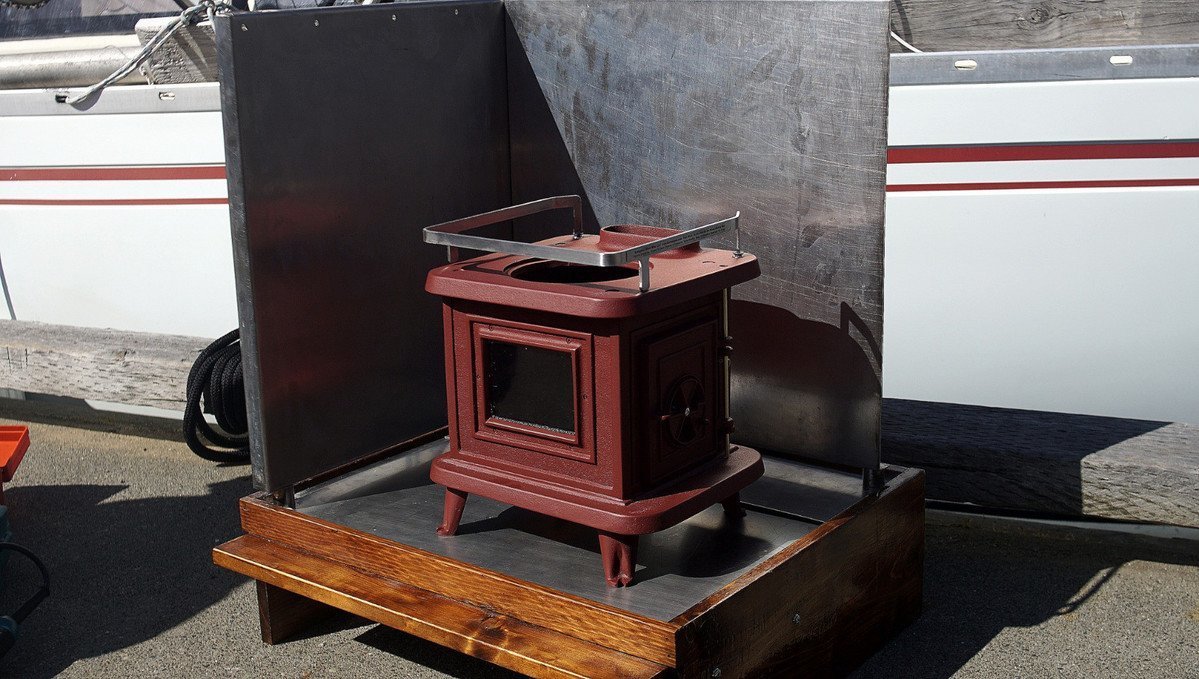
Our dock neighbor donated some short lengths of stainless steel piping that we cut down to 2.54 cm (1 inch) to use as vertical spacers for the wall shield, to allow air to circulate. Our wall shield was then mounted on the platform, and attached to the port-side wall with 2 beefy hex bolts, oversized washers and lock nuts. We added washers on both sides.
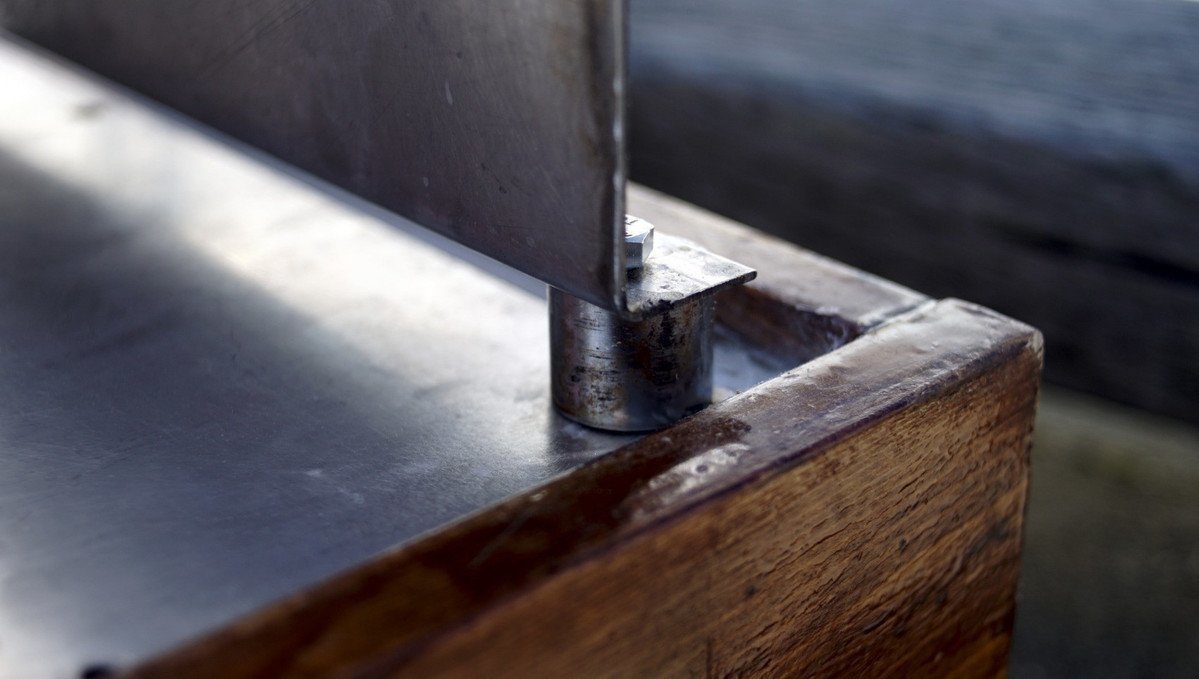
Floor protection
Our stove requires a non-combustible protection layer with a minimum R-value of R2 (thermal resistance). With K values (measure of heat conductivity), the lower value is a better insulator. With R Values, the highest number is better.
To protect our wooden platform, we bought a 1.27x121x60 cm (0.5x48x24 in) sheet of Micore 300. Micore 300 is a mineral fibre board with an R value of 2.06 per 2.54 cm (1 in), so two 1.27 cm thick layers meet the specifications for our stove.
Sourcing this material was not easy. Fireplace stores make floor pads with it but rarely sell raw sheets of the material. We found a distributor online (Concorde distributing), and they were able to direct us to a place where we could buy it locally in British Columbia (Canada). Our friends drove us to Saanichton to Pacific Fireplaces to get it. We wanted this material because it is thin, light, with a good R value per thickness. Our other option was layering sheets of heavy, X-rated gypsum, but we would have had to layer many sheets to get a value of R2—not ideal.
We cut the Micore 300 with a utility knife, with the sheet layered over plywood. Micore is brittle, you can snap/break it to complete a cut but to have sharp edges, we recommend cutting all the way through to the plywood. Micore is made with silica, so we wore gloves and cut it while outside on the dock, careful not to breath any dust.
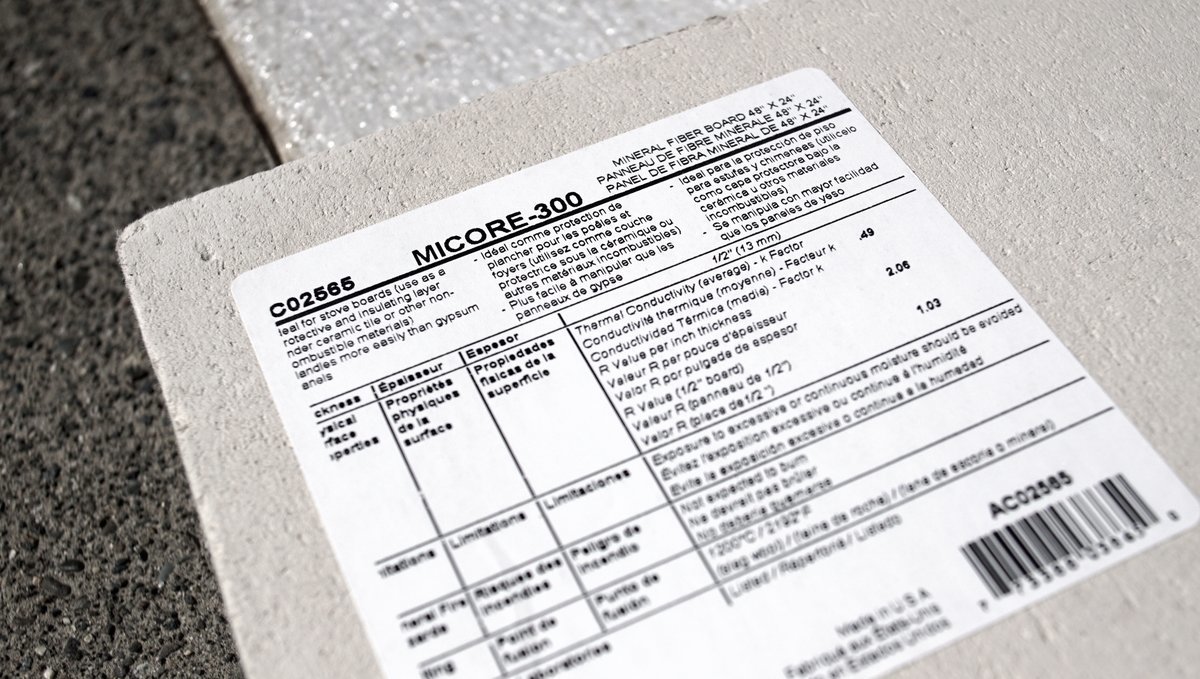
To reflect heat and to protect the sheets of Micore, we placed a thick sheet of stainless steel over top. We salvaged 3 sheets of stainless steel from the scrapyard, and cut the second piece to size to make our floor protection.
We secured the wall shield through the floor of the platform with hex bolts (through a spacer, a stainless steel sheet, 2 layers of Micore and the wood), with oversized washers and lock nuts underneath. The vertical spacers provide stability. The through-bolts for the stove legs are also secured with 0.63 cm (1/4 in) hex bolts, with corresponding washers and nuts.
Stove pipe
We bought 10 cm (4 in) diameter Dickinson stainless steel stove pipes for our stove. For our installation, we got two 45-degree elbows, and two 60 cm (24 inch) long straight pipes.
We chose single-wall stove pipes, instead of insulated because we have a water deck iron (see below).
We cut the pipes to size using our grinder, and secured each connection together with 3 sheet metal screws. We made small leading holes with a cobalt bit first to make it easier, then used our hand drill to secure them, careful not to over tighten them.
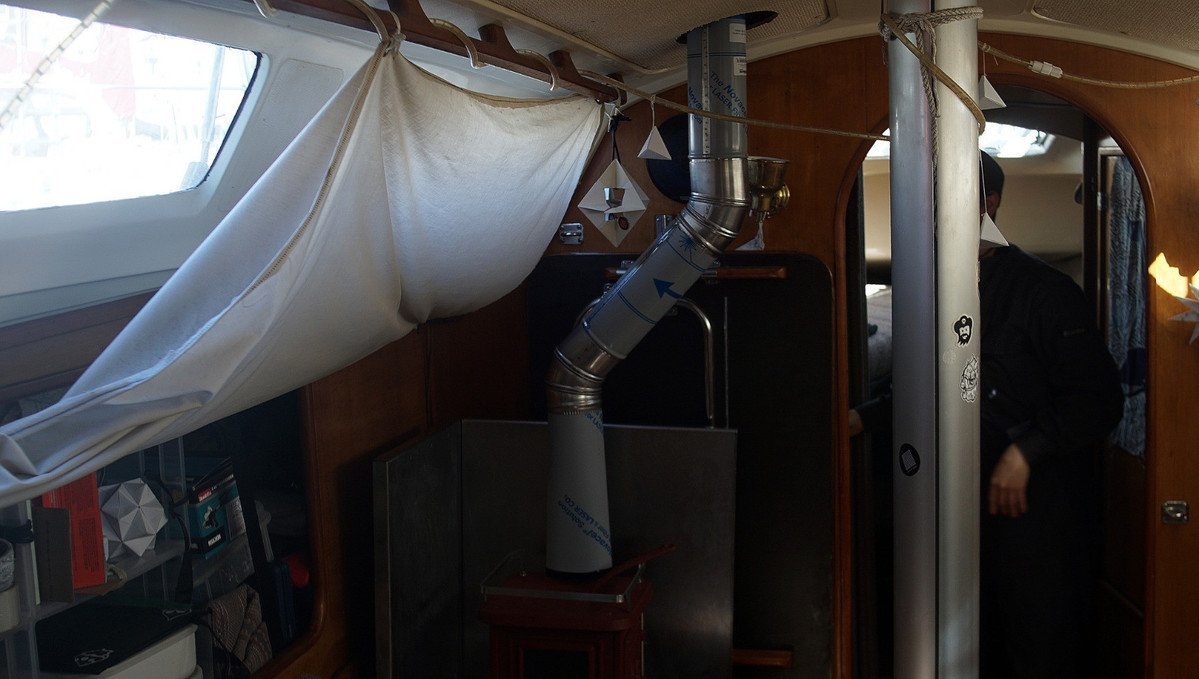
Flue damper
We installed a flue damper in the pipe to control the draft. It was difficult to slide into the space. The stove builder recommended that the damper be placed roughly 76 cm (30 in) above the cook surface. The Sardine stove needs a damper, and should not be operated without one.
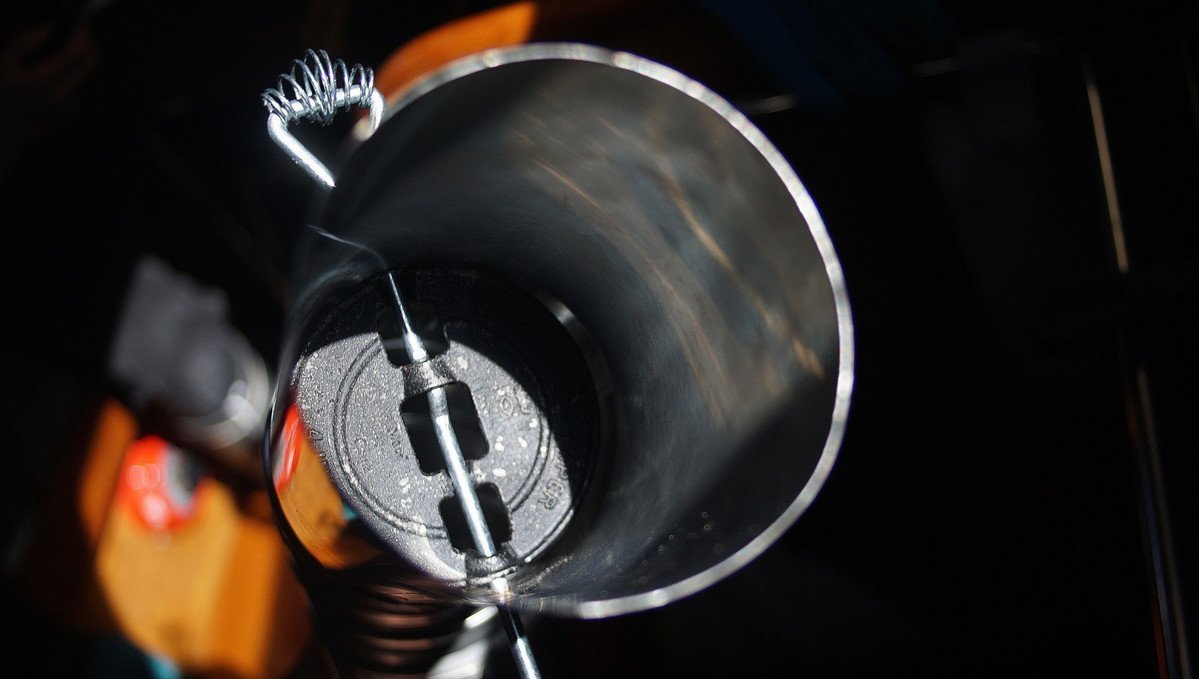
Our stove has an oval collar, so we hand formed the pipe to fit it (easy enough for single wall). Then, we used Imperial high-temp stove cement to connect the chimney pipe to the collar, gooping up the inside of the pipe. We let it set for a day.
We have plans to add shielding to the pipe itself as it nears the ceiling, but the stove pipe will never get too hot because of the water deck iron. This traditional fitting contains water in a through which surrounds and cools the chimney pipe as it passes through the deck.
Deck ring
Built a ring with a 23 cm (9 in) flange so the pipe comes out vertically, and so that the water deck iron is level with the deck. Pino's cabin top has a very gradual, but aggressive curve. We cut many wooden rings, and glued them together. When dry and solid, we sanded the rough edges to make it smooth, and added layers of fibreglass sheeting, and resin to solidify it.
We marked the placement of the hole on deck. The water deck iron requires a 17.78 cm (7 in) cut hole. To make sure the hole was aligned with the interior pipe, we drilled a small leading hole first. This would mark the center of the hole. We measured correctly, the leading hole was perfectly aligned inside. We taped a bag inside to catch some of the dust, then drilled additional holes on the edges so we could fit the jigsaw blade. Then, came time to cut a big gaping hole on Pino's deck—scary!
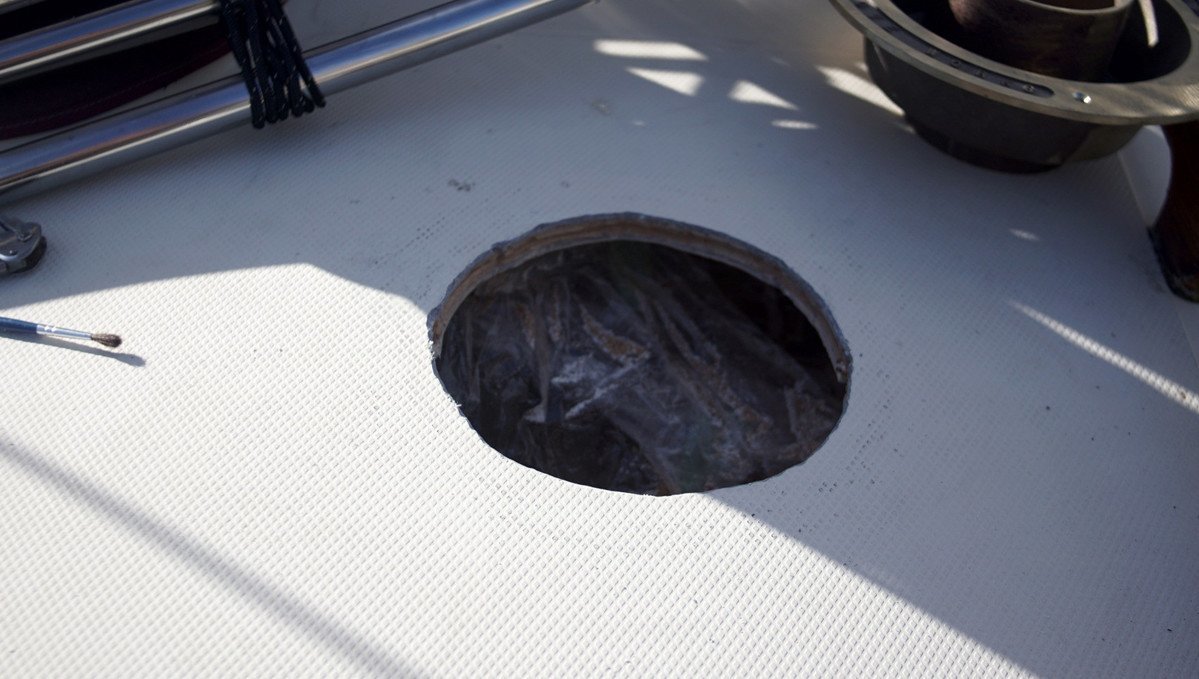
We put a rope through the hole with a knot on the inside, and attached the bitter end to a point on deck to keep the core from falling inside and into the taped bag once we completed the cut, which would send dust everywhere into the cabin.
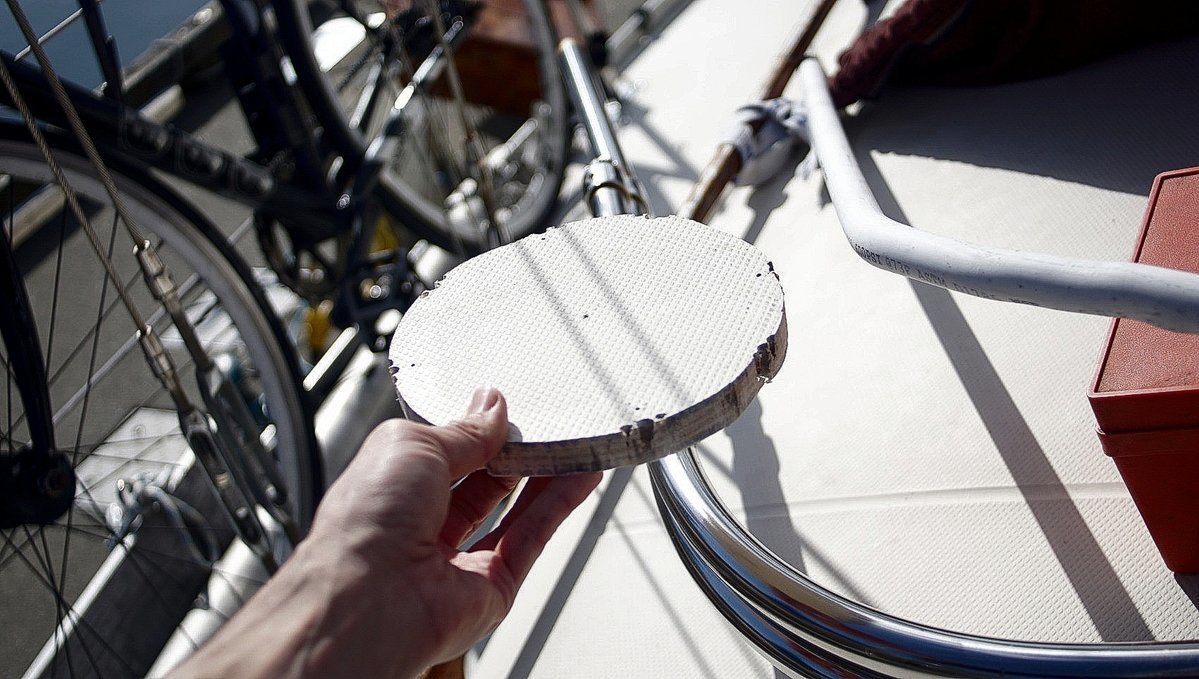
Pino's got a thick, thick core eh?
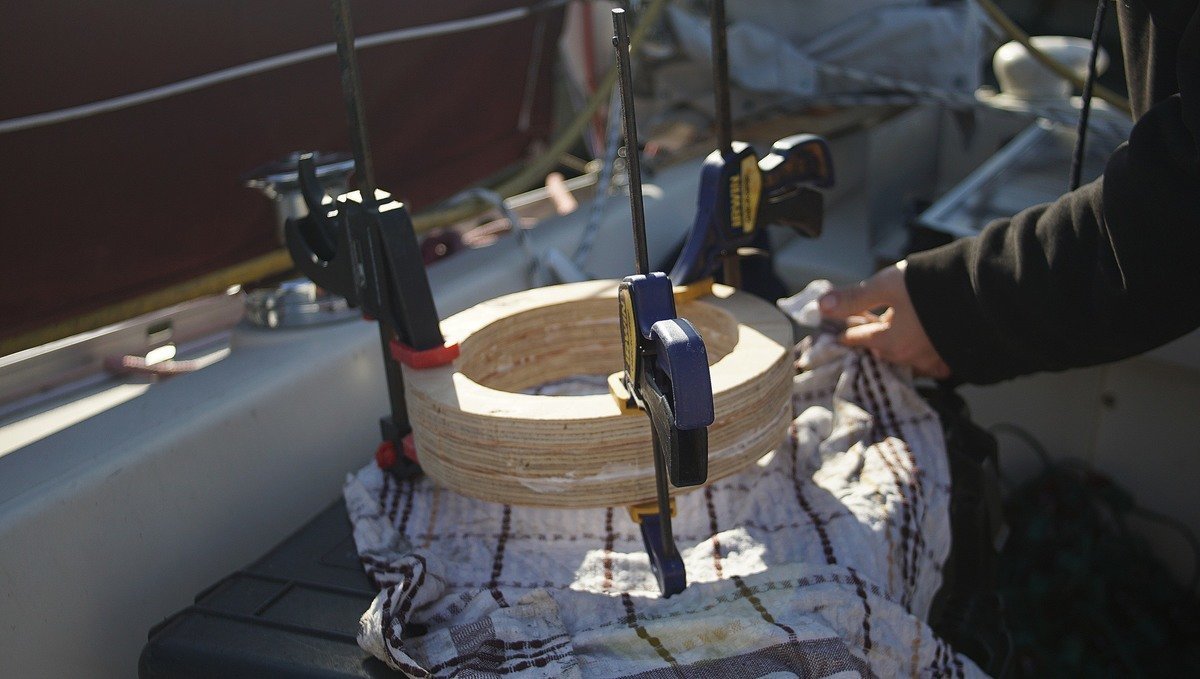
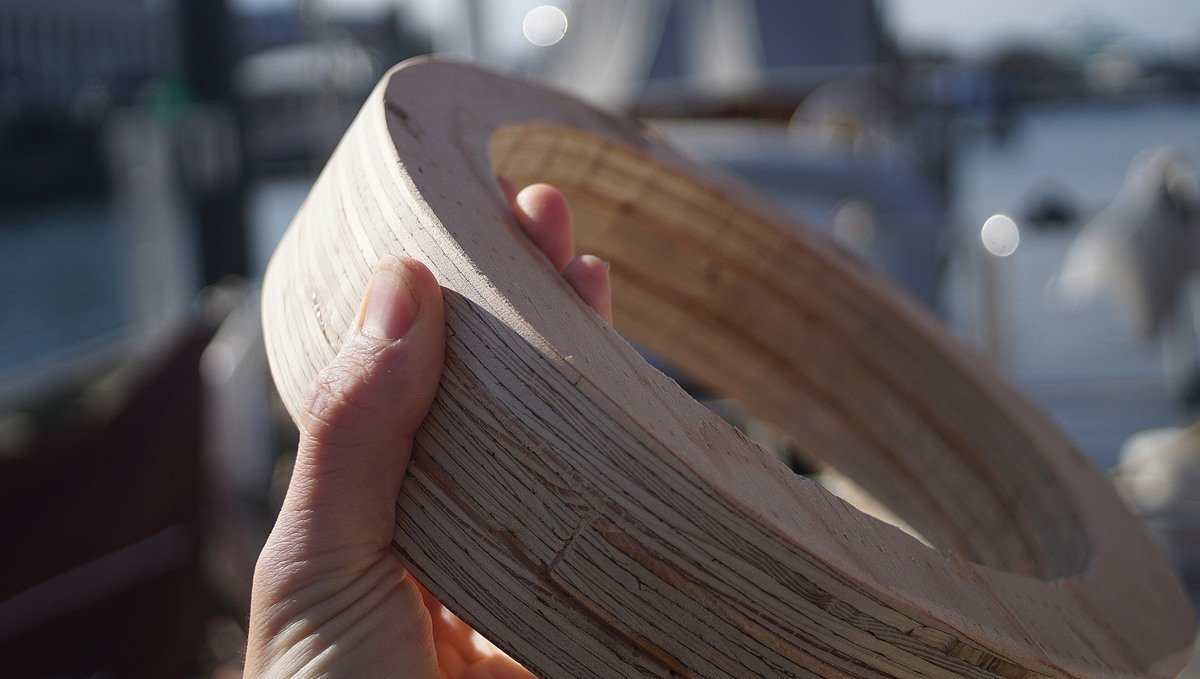
We cut the wooden deck ring at an angle with a jigsaw to level out the deck iron (not easy to do). We marked the angle with tape, secured the ring in a little bench vice and started to cut into it. Then, we fiberglassed it to the deck, and sanded down the rough ages when dry. We painted the ring so it would match Pino's gel coat color. The deck iron has to be bolted to the deck ring we made, so we placed it in the hole, and pre-drilled 4 holes (they don't go all the way through).
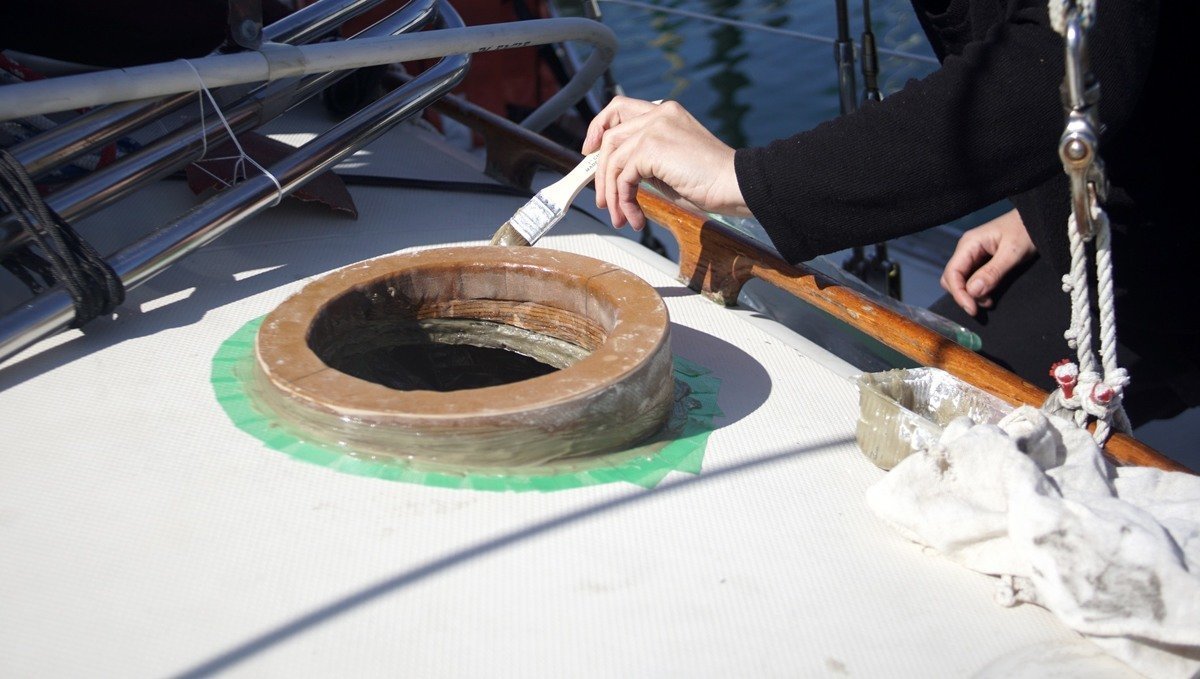
Water deck iron
The last step was to secure the brass deck iron to the deck.
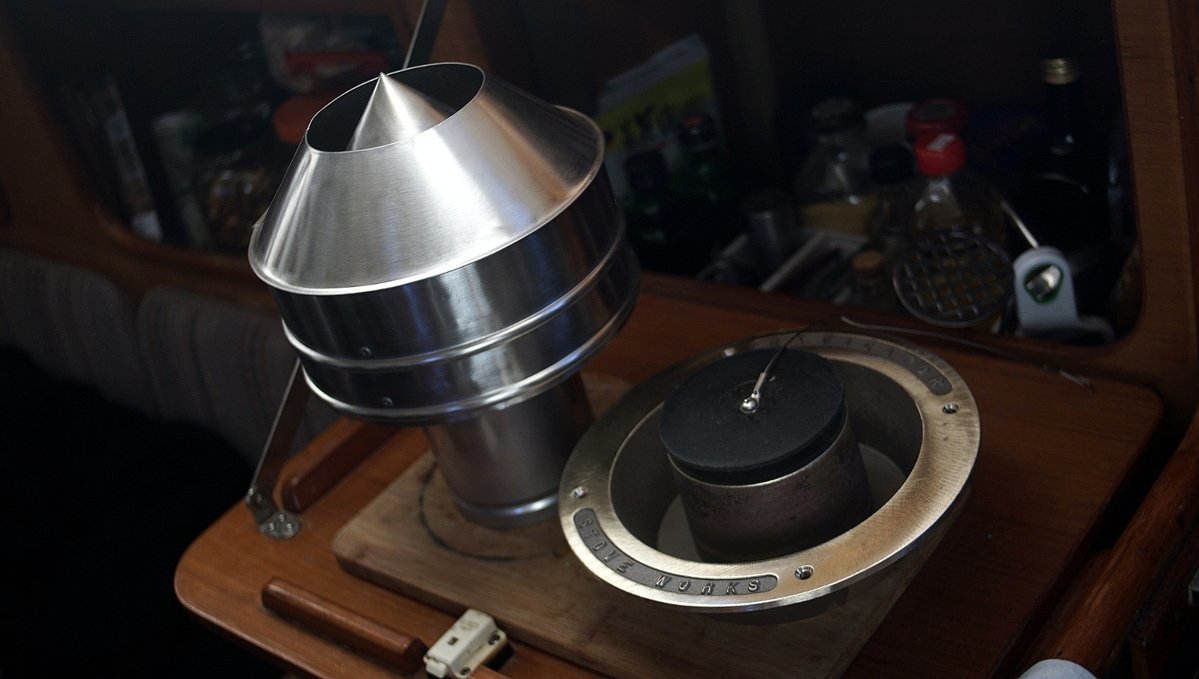
We glued some thin rubber spacers on the top of the deck ring, so that the deck iron would sit on a good layer of high-heat silicone (a warning, that stuff STINKS). Without the spacers, most of the silicone would come gushing out. Then, we taped the outside of the ring to make a clean silicone line.
We layered some silicone on the top of the ring, and laid the deck iron over top, careful to insert it in the stove pipe and to align it with the holes that we previously drilled on the top of the ring. Then, we fastened it down with some brass screws. We kept a rag close by, to wipe off our tools of the excess silicone, pushed out by the pressure of the ring as we screwed it in. We did not use a special tool to remove the excess silicone off, just the rounded end of a brush.
We have plans to add some screws inside too, to further secure the ring to the deck. We don't feel it is necessary to have through-bolts.
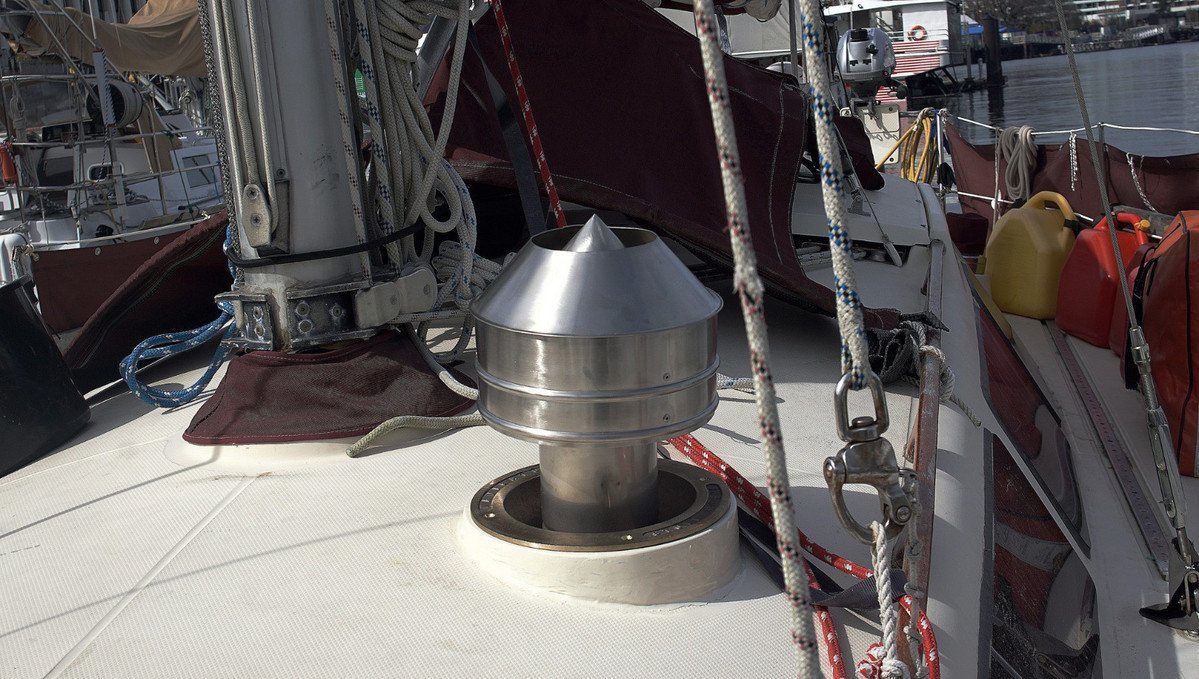
Smoke head
Pino looks great with the conical drum stainless steel smoke head! It is designed to shed rain down the outside of the pipe and into the trough. We won't be sailing with it on deck, we'll swap it out with a rubber bung while underway. The last thing we want is for a line to get caught in it and to send it flying overboard.
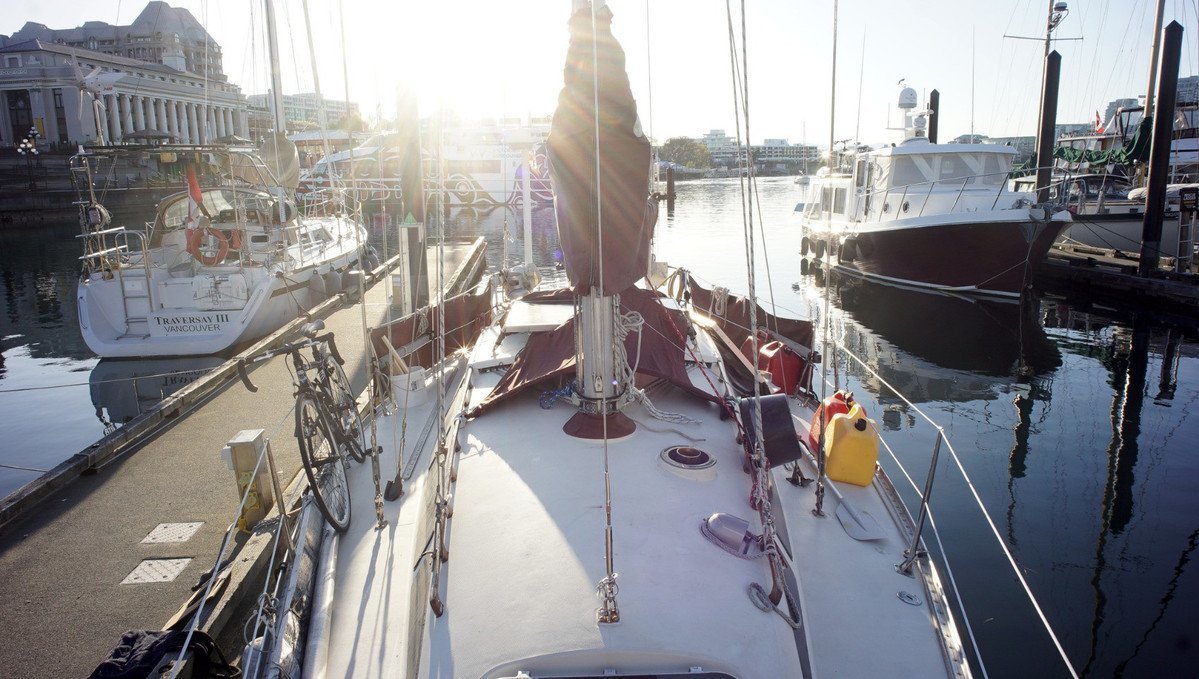
Voila! We finished most of the install on April 20th 2021. We still have some small modifications to make to our setup, but it is mostly done—just in time for summer (haha...ha).
Fan
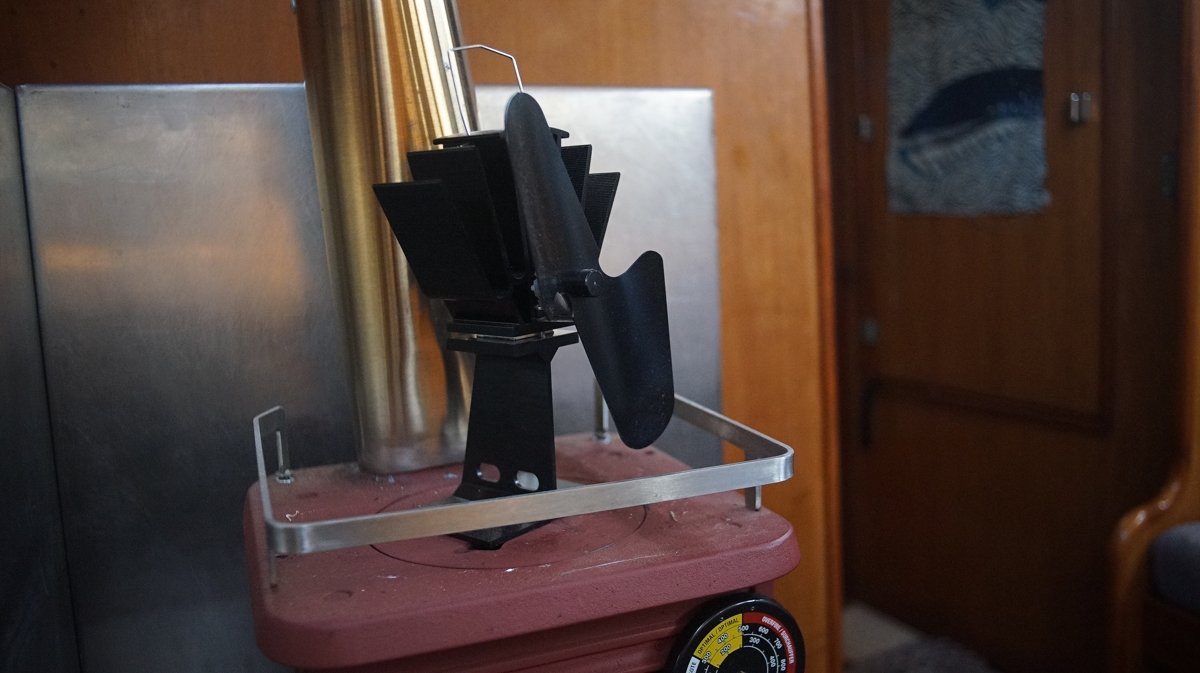
We also got a little EcoFan by Caframo. The fan helps to distribute heat throughout the space, helps save up to 10% of fuel, and doesn't use any power! The EcoFan is a little fan powered by a single TEG mat in between a diffuser and a support leg. It's powered by thermoelectricity. It's such a neat idea. We're hoping to experiment with these little mats to see if we can capture an amp or two from the wood stove.
Stove tools
It is difficult to find stove tools sized for a boat, but luckily, Cubic Mini has a great miniature set (CB-3010). Getting new tools isn't a must, we considered making them using old kitchen utensils but nearing the end of this project, our creative spirits were spent, we decided to get some instead. We also purchased the EcoFan there, since they were the only store stocking the smaller model (CB-800CAXBX, original).
Pipe shield
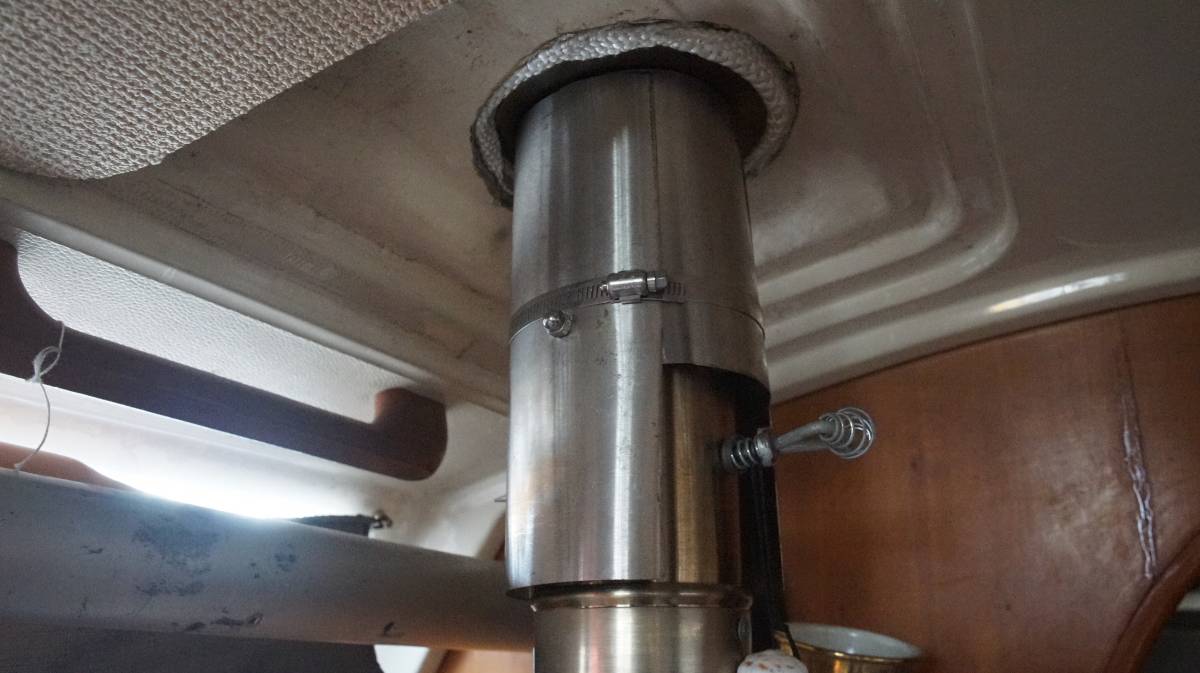
As stated earlier, our pipe is a single wall. Near the ceiling, our pipe gets a bit too near to the wooden trim, and other items that are flammable. We decided to add some extra protection. We had two choices: buy a larger diameter stove pipe (hard to find in SS), or use the left-over pipe we have and DIY a shield. We chose the second option.
We cut two lengths of stove pipe that would fit the space, and then cut them again down the middle. The pipe is 4", and so using two pipe halves will permit us to wrap around the existing pipe while providing air space. We made one hole for the end of the dampener (not visible in the photo, tail comes out the other side). The tail end of the dampener helps keep the outer pipe level. We also made two extra holes, one forward and one on the back for two bolts that we'll use as spacers. The head of the bolts are inside, laying against the inner pipe. We screwed in some nuts to increase the gap, and then the butt end of the bolt goes into the outer pipe, secured by a finishing nut. The two pipe halves fit into each other, and use the same holes (we made sure to align them). We put a big hose clamp to further secure it.
The outer pipe will act as a shield. We also added some fiberglass gasket rope for fireplaces in the ceiling between the deck iron and wall. This gasket resists abrasion, creosote adhesion, and temperatures up to 538°C(1000ºF), and is braided to resist fraying.
We'd like to add some kind of metal trim to the ceiling, but haven't yet found a suitable candidate.
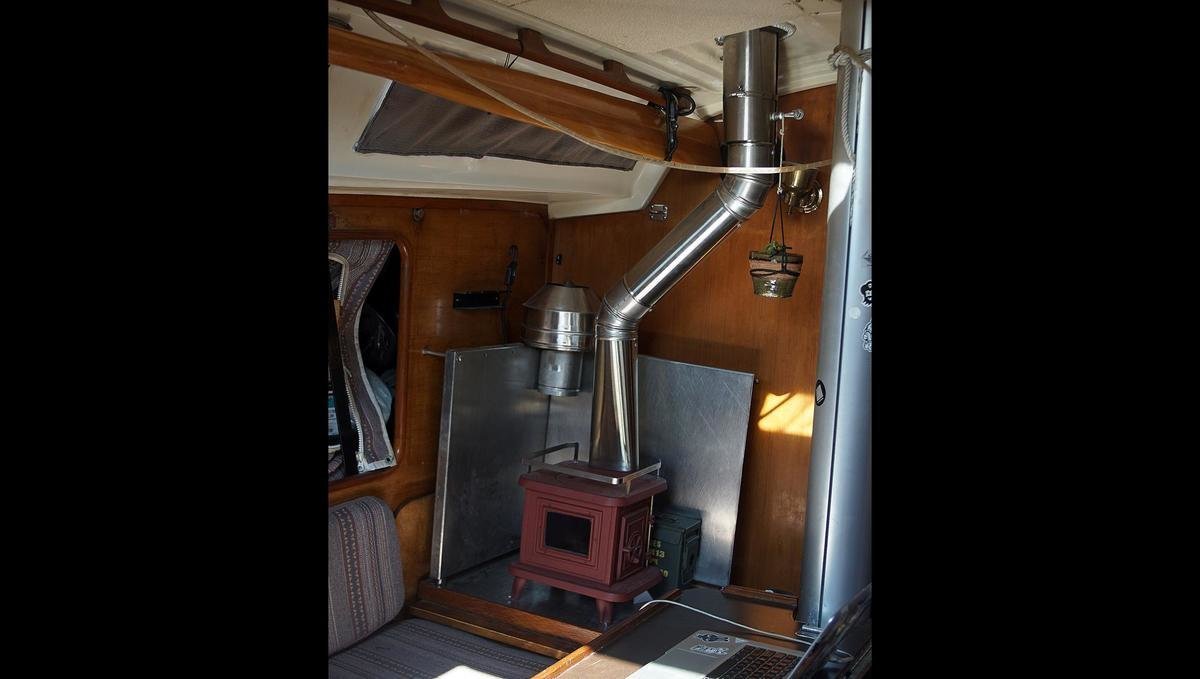
Wood box
We made a space in the outside aft locker to store wood.
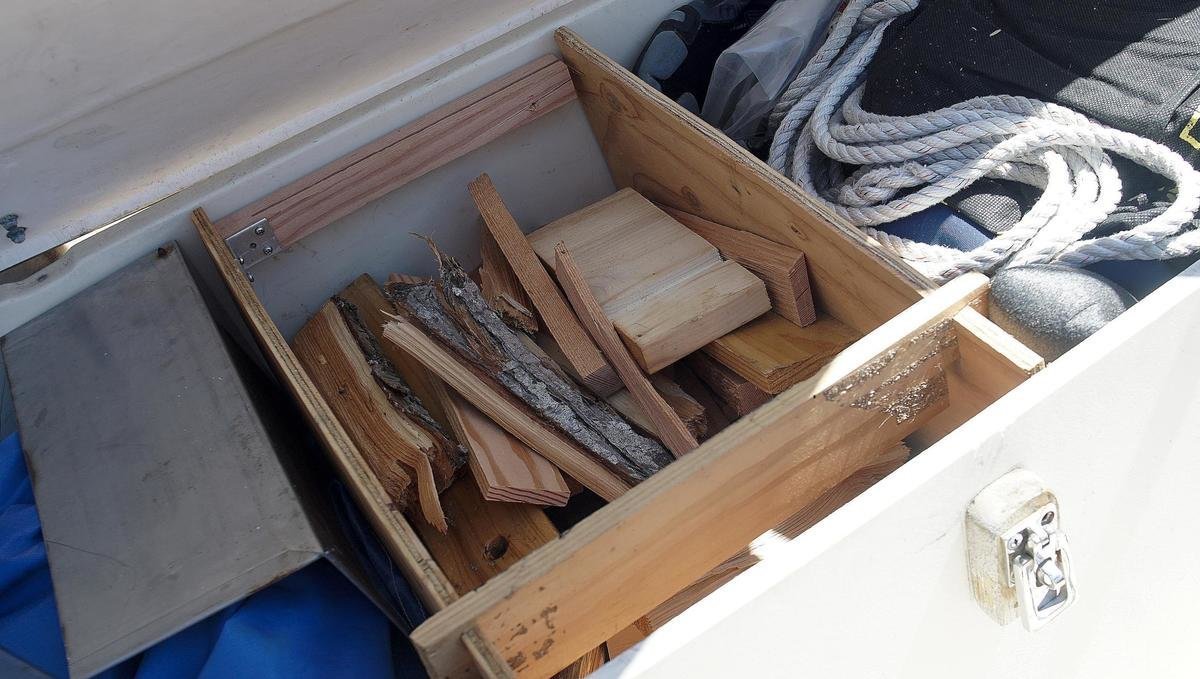
Resources
2022.10.03.
Victoria, BC, Canada
After some use, the stainless steel stove pipe has acquired a nice coppery patina.
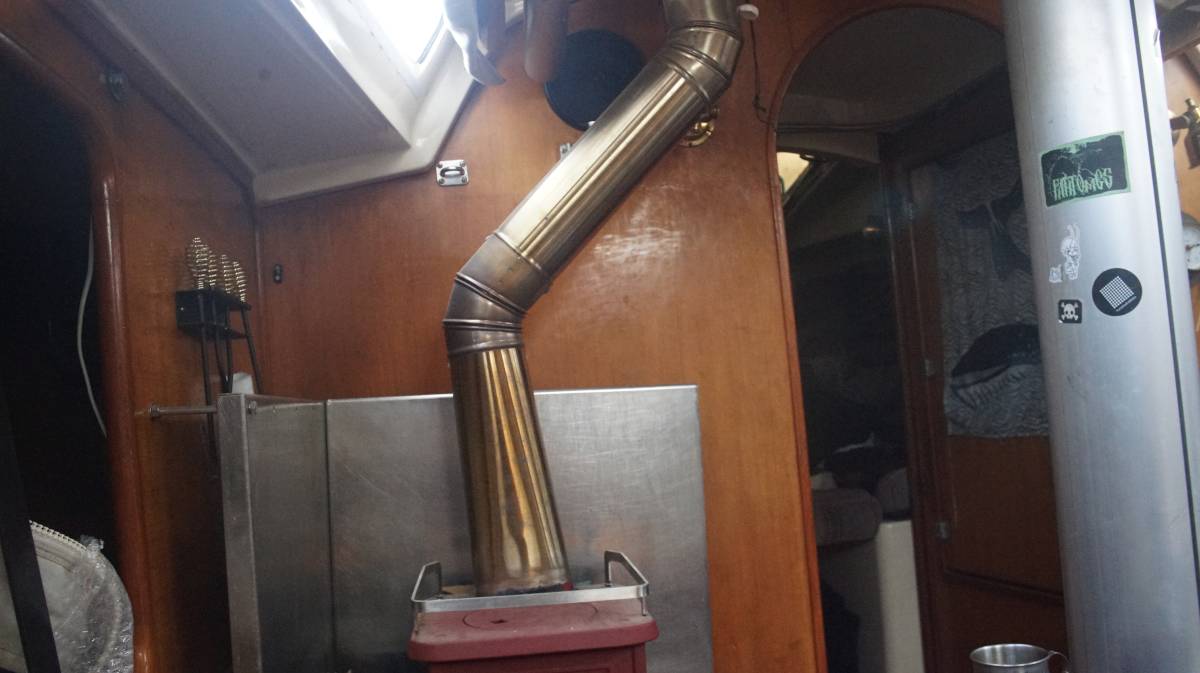
2024.10.11.
Victoria, BC, Canada
In the winter of 2023, we had several days of -15C. The very cold weather caused the wood supporting our deck iron to crack and to split, and once that started the cracking and splitting has not stopped.
When in ketchikan, after many days of hard rain, we noticed water was dripping from the ceiling onto the stove. Water was making its way past the glassed wooden ring on deck. We went outside and squirted Life-Calk into all of the visible cracks(it cures even when wet). This worked for a while, but we had to squirt it into many more cracks. Unfortunately the Life-Calk we had was a nasty brown color, it looked awful on deck... but when the weather improved we painted over the caulking with some paint matching the color of the deck. Now the deck ring looks like a nightmarish cake.
We will have to redo the deck ring...